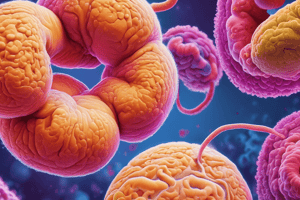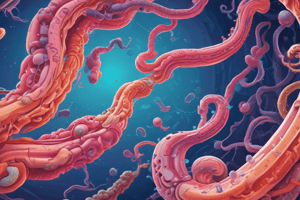Podcast
Questions and Answers
What is the primary mode of transmission of Staphylococcal food poisoning?
What is the primary mode of transmission of Staphylococcal food poisoning?
- Through contaminated food or water
- Through the hands of food handlers to foodstuffs (correct)
- Through direct contact with an infected person
- Through airborne transmission
What is the typical duration of Bacillus cereus food poisoning?
What is the typical duration of Bacillus cereus food poisoning?
- 1-6 hours
- 24 hours (correct)
- 12-24 hours
- Several days
What is the primary source of Bacillus cereus food poisoning?
What is the primary source of Bacillus cereus food poisoning?
- Unpasteurized dairy products
- Fried rice and freshly made sauces (correct)
- Undercooked meat
- Raw vegetables
What is the primary symptom of Staphylococcal food poisoning?
What is the primary symptom of Staphylococcal food poisoning?
What is the primary treatment for Staphylococcal food poisoning?
What is the primary treatment for Staphylococcal food poisoning?
What is the primary complication of Staphylococcal food poisoning?
What is the primary complication of Staphylococcal food poisoning?
What is the primary source of Escherichia coli infection?
What is the primary source of Escherichia coli infection?
What is the primary symptom of Bacillus cereus food poisoning when viable bacteria are ingested?
What is the primary symptom of Bacillus cereus food poisoning when viable bacteria are ingested?
What is the primary mechanism by which E. coli causes disease?
What is the primary mechanism by which E. coli causes disease?
What is the most common cause of travellers' diarrhoea?
What is the most common cause of travellers' diarrhoea?
Which of the following biotypes of V. cholerae O1 is more resistant to commonly used antimicrobials?
Which of the following biotypes of V. cholerae O1 is more resistant to commonly used antimicrobials?
What is the characteristic of Entero-pathogenic E. coli?
What is the characteristic of Entero-pathogenic E. coli?
What is the primary effect of the enterotoxin produced by V. cholerae O1?
What is the primary effect of the enterotoxin produced by V. cholerae O1?
What is the primary mode of transmission for cholera?
What is the primary mode of transmission for cholera?
Which of the following antibiotics is not effective against E. coli?
Which of the following antibiotics is not effective against E. coli?
What is the typical duration of survival of V. cholerae in freshwater?
What is the typical duration of survival of V. cholerae in freshwater?
What is the characteristic of the El Tor biotype of V. cholerae O1?
What is the characteristic of the El Tor biotype of V. cholerae O1?
What is the characteristic of the stool passed during cholera infection?
What is the characteristic of the stool passed during cholera infection?
What is the serotype of the new classical toxigenic strain of V. cholerae discovered in Bangladesh in 1992?
What is the serotype of the new classical toxigenic strain of V. cholerae discovered in Bangladesh in 1992?
What is the primary cause of death in cholera patients if left untreated?
What is the primary cause of death in cholera patients if left untreated?
What is the recommended intravenous fluid for rehydration in cholera patients?
What is the recommended intravenous fluid for rehydration in cholera patients?
What is the benefit of using oral rehydration solutions with resistant starch in cholera patients?
What is the benefit of using oral rehydration solutions with resistant starch in cholera patients?
What is the characteristic of cholera sicca?
What is the characteristic of cholera sicca?
What is the diagnostic feature of V. cholerae observed under dark-field microscopy?
What is the diagnostic feature of V. cholerae observed under dark-field microscopy?
Flashcards are hidden until you start studying
Study Notes
Gastrointestinal Bacterial Diseases
Gastrointestinal Food Poisoning
- Staphylococcal food poisoning: transmission through food handlers' hands to dairy products, cooked meats, and inappropriate storage, leading to nausea, vomiting, and diarrhea within 1-6 hours.
- Bacillus cereus food poisoning: ingestion of pre-formed heat-stable exotoxins, causing rapid onset of vomiting and diarrhea within hours, with self-limiting symptoms.
Gastrointestinal Infection
- Campylobacter jejuni infection: a common cause of diarrheal illness.
- Salmonella spp. infection: a common cause of foodborne illness.
- Escherichia coli infection:
- Many serotypes present in the human gut, with production of disease depending on colonization or acquisition of pathogenicity factors.
- Five clinico-pathological patterns of diarrhea associated with specific strains of E. coli.
- Travel to unfamiliar areas can lead to contact with different strains of E. coli, causing traveler's diarrhea.
- Antimicrobial agents, such as β-lactams, fluoroquinolones, aminoglycosides, and trimethoprim-sulfamethoxazole, can effectively inhibit E. coli growth.
- Clostridium difficile infection: a common cause of antibiotic-associated diarrhea.
- Yersinia enterocolitica infection: a common cause of foodborne illness.
- Cholera (Vibriosis):
- Caused by Vibrio cholerae serotype O1, with two biotypes: classical and El Tor.
- The seventh pandemic began in 1961 and spread via the Middle East to become endemic in Africa.
- El Tor is more resistant to commonly used antimicrobials than classical Vibrio.
- A new classical toxigenic strain, serotype O139, was discovered in Bangladesh in 1992 and started a new pandemic.
- Infection spreads via contaminated water, shellfish, food, and human contact.
- Clinical features include severe diarrhea, vomiting, and dehydration, leading to shock and oliguria if left untreated.
- Diagnosis is confirmed bacteriologically, and treatment involves replacement of water and electrolytes.
- Bacillary dysentery (shigellosis): a common cause of foodborne illness.
Studying That Suits You
Use AI to generate personalized quizzes and flashcards to suit your learning preferences.




